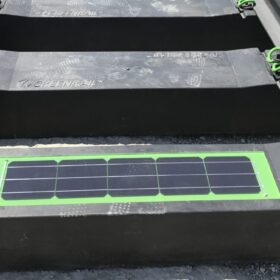GameChange Solar, JZNEE to build 3 GW tracker factory in Saudi Arabia
GameChange Solar, a US-based tracker supplier, has announced the construction of a 3 GW tracker factory in Saudi Arabia, with plans for potential expansion to 5 GW in the future.
Solar module cooling tech based on waste neem oil
An international research team has placed a neem oil tank on the back of solar modules for cooling purposes. The proposed solution reportedly improves PV panel performance by up to 17.8%.
Indian researchers develop solar cell from living algae
The researcher team, from Amrita Vishwa Vidyapeetham university in Coimbatore, India, sandwiched macroalgae between a carbon-coated copper electrode and a titanium oxide-coated fluorine-doped tin oxide electrode. The 1 cm2 device exhibited a 1.25 mA photocurrent and 0.5 V photovoltage under UV light.
How safe are lithium iron phosphate batteries?
Researchers in the United Kingdom have analyzed lithium-ion battery thermal runaway off-gas and have found that nickel manganese cobalt (NMC) batteries generate larger specific off-gas volumes, while lithium iron phosphate (LFP) batteries are a greater flammability hazard and show greater toxicity, depending on relative state of charge (SOC).
Italian startup testing PV sleepers on railway line
Greenrail Group has started deploying special its PV railroad-tie solution along a railway line in Emilia Romagna, Italy. The company designed the system according to the UNI 10349 standard.
US government funds pilot project for heated sand energy storage
The US Department of Energy is funding a pilot project to demonstrate the commercial viability of storing energy in heated sand, which is capable of producing 135 MW of power for five days.
Growatt launches new balcony storage solution
The new product combines the NEO 800TL-X Microinverter and the NOAH 2000 Battery. Up to four batteries can be stacked, for up to 8,192 Wh of storage capacity.
Sodium-ion batteries – a viable alternative to lithium?
While lithium ion battery prices are falling again, interest in sodium ion (Na-ion) energy storage has not waned. With a global ramp-up of cell manufacturing capacity under way, it remains unclear whether this promising technology can tip the scales on supply and demand. Marija Maisch reports.
Evaluating the profitability of vanadium flow batteries
Researchers in Italy have estimated the profitability of future vanadium redox flow batteries based on real device and market parameters and found that market evolutions are heading to much more competitive systems, with capital costs down to €260/kWh at a storage duration of 10 hours.
How to convert PV plants with dual-axis trackers into agrivoltaic facilities
A Spanish group of researchers has investigated how much agricultural production may be hosted by existing ground-mounted PV plants using dual-axis trackers. They outlined a new methodology that reportedly enables to quantify how much space around and beneath the panels can be uses for agricultural purposes.













